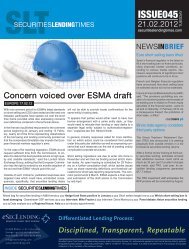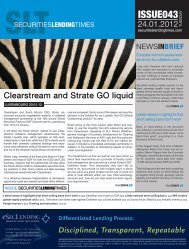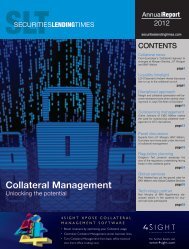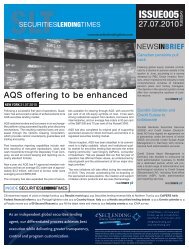read - Securities Lending Times
read - Securities Lending Times
read - Securities Lending Times
You also want an ePaper? Increase the reach of your titles
YUMPU automatically turns print PDFs into web optimized ePapers that Google loves.
IMA defends UK stock lending<br />
disclosures in UK<br />
Continued from page 1<br />
In response, Miller said that “the IMA continues<br />
to condone very poor transparency of charges,<br />
investments and risks by its members. The<br />
IMA does not seem to agree with Donald Kohn,<br />
external member of the Bank of England’s [Interim]<br />
Financial Policy Committee, who has<br />
called for greater transparency among financial<br />
institutions, instruments, and markets, and for<br />
institutions to provide timely, up-to-date, and<br />
comprehensive information.”<br />
What prompted Miller to conduct the research,<br />
was increased regulatory scrutiny of exchange<br />
traded funds (ETFs), which have been in the<br />
spotlight as both the European <strong>Securities</strong> and<br />
Markets Authority (ESMA) and the Australian<br />
<strong>Securities</strong> Investment Commission (ASIC) have<br />
issued guidance which, among other things,<br />
recommends explicit disclosures of securities<br />
lending practices for those specific products.<br />
But Miller claimed the FSA appears to take this<br />
seriously within just synthetic ETFs, having seemingly<br />
completely ignored the similar risks within<br />
physical ETFs, mutual funds, structured products<br />
and the financial sp<strong>read</strong> betting industry.<br />
“If the FSA is suddenly going to start regulating<br />
products on the basis of whether investors<br />
can understand them, one would have thought<br />
the FSA would take it very seriously that those<br />
funds should provide the information to investors<br />
so they can be aware of and able to analyse<br />
the risks involved,” Miller added.<br />
Another concern highlighted by the survey is the<br />
lack of transparency in how fees earned from<br />
securities lending business within the fund is<br />
split with investors.<br />
“You would expect there to be some justification<br />
for the split of fees between company and investor,<br />
as the investor normally takes 100 per cent of<br />
the risk,” Miller said. “The rules basically allow the<br />
majority of such fees to be kept by the stock lending<br />
agent and the fund manager and the minority<br />
of it passed on to the client. Why should there<br />
not be a prescribed minimum amount which is<br />
passed on to the fund investors?”<br />
He noted, however, that there are good examples<br />
of fund managers engaging in securities<br />
lending, such as T. Rowe Price and Vanguard in<br />
the US, passing on the vast majority of the fees<br />
back to investors. SCM Private does not directly<br />
take part in stock lending, but through its investments<br />
in exchange traded funds is exposed to<br />
stock lending within some of these funds. However,<br />
Miller noted that this does not take place<br />
within the synthetic ETFs which it holds as the<br />
securities lending by the banks running these<br />
funds is normally outside the ETF.<br />
Lombard Risk updates<br />
reporting solution<br />
Continued from page 1<br />
The Lombard Risk regulatory reporting solution<br />
is used by more than 250 firms around the<br />
world; over 40 per cent of the UK-based financial<br />
institutions use it to submit FSA and Bank<br />
of England returns; and last year Lombard Risk<br />
saw 30+ firms use its regulatory reporting, with<br />
LISA for liquidity scenario analysis, to meet the<br />
FSA’s tough new liquidity regulations.<br />
John Wisbey, CEO of Lombard Risk said: “We<br />
have listened very carefully to our 250+ large<br />
and small clients alike in various countries, and<br />
to other firms that are looking for a robust, multicountry<br />
reporting solution architecture to cope<br />
with all the regulatory change that is occurring.<br />
This enhanced, web-based version is driven<br />
by our own vision of modern regulatory reporting,<br />
and addresses the major business issues<br />
raised by the many firms we have talked to.<br />
Our aim is that no serious firm that is looking<br />
at regulatory reporting, whether in one country<br />
or across multiple jurisdictions, can leave us off<br />
their shopping list”.<br />
NewsInBrief<br />
Nick Davies, CTO of Lombard Risk said: “Implementing<br />
our roadmap vision using industry<br />
tried and tested web-based workflow technologies,<br />
Lombard Risk has taken the best of what<br />
made STB-ReporterV4 one of the world’s most<br />
installed regulatory platforms on a global basis,<br />
and has created its next-generation web platform<br />
that not only addresses new drivers but<br />
reduces total cost of ownership and significantly<br />
improves return on investment. The Lombard<br />
Risk solution will ensure that our clients have<br />
all the information they need to prevent submission<br />
issues with their regulators, regardless of<br />
the country, and that direct bottom line impact is<br />
reduced in an ever increasing complex regulatory<br />
landscape.”<br />
Lombard Risk’s new web-based regulatory<br />
compliance solution, which was recently shown<br />
to 100 invited guests at the British Bankers’<br />
Association, provides regulatory reporting,<br />
stress testing and scenario analysis together<br />
with management / business information on a<br />
fast, flexible and fully-integrated web platform.<br />
The new solution has been developed in direct<br />
response to the increasing and changing demands<br />
of global regulators for transparency and<br />
insight into firms’ operations at a detailed level<br />
- and will enable them to meet these requirements<br />
with confidence.<br />
Broadridge acquires Paladyne<br />
Continued from page 1<br />
“Buy-side firms purchase nearly 40 per cent of<br />
capital markets technology and services and<br />
represent a segment of virtually untapped opportunity<br />
for Broadridge. Paladyne will serve<br />
as the foundation for the expansion of Broadridge’s<br />
buy-side offering, enabling us to bring<br />
Paladyne’s unique solutions to hedge funds,<br />
our existing prime brokerage clients, asset<br />
managers, hedge fund administrators and other<br />
asset servicers.”<br />
“Broadridge has exceptional client loyalty and<br />
an outstanding reputation for service, dependability,<br />
and cost effectiveness. Broadridge’s<br />
extensive reach in the global financial services<br />
community and its global sales and distribution<br />
capabilities will enable Paladyne to expand<br />
significantly into new and existing market segments,”<br />
said Sameer Shalaby, chief executive<br />
officer, Paladyne Systems. “Broadridge’s proven<br />
sell-side solutions and client-focused services<br />
in combination with Paladyne’s innovative<br />
buy-side technology creates one of the most<br />
comprehensive technology and services offerings<br />
within the financial services industry.”<br />
MXConsulting<br />
MX Consulting is currently delivering solutions to<br />
clients within Agent <strong>Lending</strong>, Custodial and Principal<br />
<strong>Securities</strong> Financing Programmes.<br />
A business & IT consultancy<br />
dedicated to the <strong>Securities</strong><br />
Financing Industry<br />
Why use a consultancy that isn’t<br />
specialised?<br />
www.mxcs.co.uk<br />
3<br />
www.securitieslendingtimes.com












